




































































































Matt Blackburn | AGSA President
As we approach the 2025 conference season I hope everyone has enjoyed the Holidays and had some down time. This year we return to the Weston in Halifax. Hopefully the weather cooperates better than the last couple of years. Last year didn’t have any impact on the program but did make for an interesting night on the town and some interesting driving. With the shift in calendar days we are not falling on Valentine’s Day or Family Day, which I know has been a challenge for some. The conferences in other areas make it tough to find dates where potential speakers won’t have conflicts. We seem to be in a good slot and even better now without the Holiday conflicts.
I am excited about the speaker line up and would like to thank the Conference Committee members for their work on the program. The initial numbers are showing that we will have strong attendance again this year. This strong attendance provides even more opportunities to network with other superintendents and industry partners. There will be lots of great information for courses of all sizes and all budgets. AGSA members are always willing to share, so I invite you to take part, broaden your knowledge and celebrate the success of our members.
We continue to look at ways to improve the conference and add value. We hope you will enjoy and take advantage of this year’s additions.
See you in Halifax!
Matt Blackburn Superintendent Chester Golf Club
AGSA President









GeoLink Spray is the industry’s first turf based precision spray system. Turf professionals benefit from substantial chemical savings thanks to individual nozzle control and sub-inch accuracy. GeoLink Steer for the Multi Pro 5800, allows the operator to utilize GPS guided steering, ensuring the machine follows the optimal next pass which provides improved consistency and less dependence on operator skill level.



GeoLink Spray utilizes cellular Real Time Kinematic (RTK) correction technology to provide sub-inch accuracy. This sophisticated communication system receives location data from multiple satellites and a correction source to provide precise location information. This gives the user the ability to map each spray area only once and spray with precision year after year. Increased Efficiency – Waste is virtually eliminated. The system automatically turns individual nozzles on and off based on the machine’s exact location. This eliminates costly overlaps and missed strips.
A large, weatherproof, touch screen shows the machine’s location and allows the operator to create and choose spray jobs containing multiple spray zones. When the job is finished, the system provides accurate job reports that can be downloaded for analysis.







Now available, Toro GeoLink® Spray with GeoLink® Steer for the Multi Pro 5800, virtually takes operator error out of the equation. With the touch of a button, GPSguided steering takes over, ensuring full boom utilization for even more accuracy and time savings. And the onboard nudge feature helps reduce turf wear by varying the travel path from application to application.



We are thrilled to invite you to the 2025 AGSA Conference and Trade Show, taking place from February 10-13 at the Westin Hotel in Halifax.
We are particularly excited about our speakers' program this year, featuring both pre-conference seminars and an education program sponsored by Syngenta! Additionally, we are delighted to announce that our trade show is nearly sold out. We extend our gratitude to our corporate sponsors for their support and extend a special welcome to our new corporate members who will be exhibiting at this year's show.
This year, we have added some exciting features, including a pesticide training session on Monday afternoon that will add points towards your pesticide license renewal. Mechanics Day is back at the Links at Brunello on Tuesday, offering lunch and great discussion topics on current advancements in equipment.
Don't forget to join us for the awards banquet on Wednesday night, a highlight of the conference. The banquet will feature a delicious meal, an opportunity to network with fellow attendees, and a chance to celebrate the achievements of our community. We will honor this year's award and scholarship recipients, recognizing their hard work and dedication. It's an evening you won't want to miss!
Halifax is a fantastic city with much to offer. Known for its rich maritime history, vibrant cultural scene, and stunning coastal views, Halifax is a place where you can enjoy both urban amenities and natural beauty. Take some time to explore the historic waterfront, visit the iconic Citadel Hill, or enjoy the local cuisine at one of the many excellent restaurants. Whether you're interested in history, art, or outdoor activities, Halifax has something for everyone.
For all the details you need, please visit our conference website at https://agsa.ca/2025-conference-home-page/
We look forward to seeing you at the show in February!
Rene George Chairman
2025 AGSA Conference




TUESDAY, FEBRUARY 11
7:00 AM Registration
8:30 AM – 12:00 PM Dr. Thomas Nikolai - Soil, Water Air and BMP
NOON – 1:00 PM LUNCH – Participants taking morning & afternoon seminars
12:45 PM – 4:00 PM Dr. Kevin Frank - Winterkill: Lessons learned for mitigating damage, reestablishing greens and current winter research efforts
4:15 PM – 5:00 PM Reception (Mezzanine)
5:00 PM – 7:00 PM Trade Show Opening - Commonwealth Room
WEDNESDAY, FEBRUARY 12
7:00 AM Registration
7:30 AM – 7:45 AM OPENING REMARKS – Conference Chair/President/Syngenta
7:45 AM – 9:00 AM Matt Legg - Syngenta Syngenta - TT
9:00 AM – 10:00 AM Thomas Nikolai - Top 10 reasons for lightweight rolling
10:00 AM – 11:00 AM Kevin Frank - Comparing soil testing philosophies - SLAN vs MLSN
11:00 AM – 2:00 PM TRADE SHOW OPEN– Dedicated trade show time, including lunch being served on the trade show floor
2:00 PM – 2:20 PM T T - Belchim
2:20 PM – 3:30 PM Architect (Christine/John)
3:30 PM – 4:30 PM Matt Fleetwood - Aquatrols
4:30 PM – 4:45 PM T T- Envu
6:00 PM – 6:30 PM PRESIDENT ’S RECEPTION
6:30 PM – 8:30 PM AWARDS BANQUET
THURSDAY, FEBRUARY 13
8:00 AM – 9:00 AM Patricia Miller - Envu - Green Solution Specialist - Nematodes??
9:00 AM – 9:20 AM T T - Nova Turf
9:20 AM – 10:20 Paul MacCormack
10:20 AM – 10:40 AM T T - Aquatrols
10:45 AM – 12:15 PM AGSA Panel Discussion - Bunker Construction/Renovation/Drainage/ Sand - Moderated by Paul MacCormack
12:15 PM – 12:20 PM Closing Remarks
Michigan State University
Kevin Frank is a professor and state extension turfgrass specialist at Michigan State University. He holds a M.S. and Ph.D. in Horticulture from the University of Nebraska and B.S. in Plant Science from the University of Wyoming. Dr. Frank’s research interests include winterkill prevention and reestablishment, turfgrass nutrition, fate, and fertilizer programming. He serves as the MSU Turfgrass Committee Chair and as the MSU Liaison to the Golf Association of Michigan.
Seminar: Winterkill: Lessons learned for mitigating damage and reestablishing greens
Michigan State University
Thomas A. Nikolai, Ph.D. has been performing turfgrass research and teaching at Michigan State University since 1992. Areas of research interest include cultural and mechanical practices and their relevance to decreasing inputs. University courses Nikolai has taught include Turfgrass and the Environment, Pesticide and Fertilizer Technology, World of Soils, Turfgrass Irrigation, Turfgrass Management and Turf and Landscape Analytical Practices. Thom has given presentation in 30 countries, 8 Canadian Provinces, and 36 States.
Seminar: Soil, Water, Air and BMP
FEBRUARY 11-13, 2025

Do we have the "Silver Bullet" of aeration for you? You likely suspect that we would come out and say that the newest addition to EV Turf services is the end all and be all but the truth is it is just one more tool that you have access to. Core, solid, deep tine, air inject, media inject (Dryject), and Drill & Fill aeration are all fantastic ways that work together for you. Is there a perfect recipe? Is one better than the other? No, and No .....
Each club has its own set of variables and each green at those clubs sometimes has its own issues and we use the tools/contractors available to us. I have been part of the Drill & Fill process for several years dating back to when I brought that process to Ontario with Zander Sod. I've seen with this process greens getting rebuilt from the inside out to tackle problem areas and each club and green has its own set of variables. Some think that it is only for older push-ups trying to change up the soil profile but how about a spec green and only doing the "drill" aspect? Drill aeration into a spec profile can yield amazing results that are deeper than any other process. Now for a club wanting to switch out profiles without blowing up the green and starting from scratch costing $$$ and taking the green out of play for months before having it "dialed" in even if sodded, what is the Silver Bullet? We all have different experiences so different approaches and opinions on this..... My approach even includes a service (Dryject) that we don't offer but would use with other processes if it were my club...
What is the best aeration type? That is a loaded question with way too many answers and each one would be correct as the super is thinking of their set of variables.
Profile injection is yet another fantastic process that is usually contracted (Dryject). Injection processes of the past used to blast into the profile and sometimes create a bulb of sand deeper down into the profile, but now machines have more control and precision, creating a sand column or perhaps only going down 2-3 inches (pending target depth area), diluting organic matter where it counts.
Drill aeration - spec sand green or push-ups? I won't get into different bit sizes and sand volumes but get to the short and skinny. I believe this all started under the Floyd McKay name and essentially is a large drill press platform excavating material from the green. Some would say this could be accomplished with a large coring tine and to some degree they are right but nothing truly measures up to drill aeration. Great way to revitalize or be in front of curve on a spec green bringing up material in the drill and just brush it back in as you would topdressing after standard aeration. The holes will not be filled like the drill & fill process but will slightly collapse over time and create a path for better drainage. Because it is a 7" pattern the structural stability of the green is still solid even without the backfill. Now with the "Fill" you can rebuild a green from the inside out! A hopper of kiln-dried material sits above the drill and will directly into the holes after the drill process.
Deep tine- the question..." to heave or not to heave?" Would always recommend a small amount of heave (5 deg) for two reasons. First is that with the forward movement of the tractor, the tine exits the hole cleaner. Second is that you achieve more with less visibility on the surface. For example, when using a 12mm tine going 20cm deep and 5 deg of heave or kick creates movement at the 20 cm depth creates a 19.5 mm pocket. Could you imagine 19.5mm on the surface? Even though these units have capabilities of 10-12' depths I've been asked on several occasions to achieve a depth marginally deeper than their traditional unit but with kick/heave breaking up the layer developed over the years.
VLA- vertical linear aeration is a fantastic option and is completely different from the standard reciprocating units. This is ideal for hardpan areas that would be too abusive on a standard unit. For areas perhaps with rock it is amazing and the only unit for the job when wanting to achieve any sort of depth compared to a rolling drum style traditionally used in a rocky environment.
Core/Solid? - again no right or wrong pending what the club is dealing with. Venting, thatch removal, decompaction, switching out soil profile, etc... Should thatch management be mechanical or chemical? Coring tines have gotten so small now that tight spacing covers more surface area than larger tines with far less recovery time which equates to less disruption in play. This sometimes will allow the club to punch with higher frequency and get to their goal much faster.
Air injection - this process certainly won't help you with thatch management, (or will it?) as all the work is done below grade but is meant to improve soil bulk densities and with this better particle spacing increase air/gas and water movement.
Thank you for reading and thinking of us as an extension of your turf dept!
Dr. John Dempsey

As all sportsturf managers, greenkeepers and groundsmen know, to provide top quality playing surfaces plant nutrition is vital. A balanced nutritional program, tailored to the specific needs of the sports surface, and taking account of the nutritional status of the rootzone is a key factor in successful turfgrass management.
Today though, I’m not going to get into all the specifics of nutrient programs, there’s no shortage of information re that and certainly no shortage of advice as to what products to use!!
What I am going to talk about is how many elements and compounds, apart from supplying essential nutrition, can also have added benefits in enhancing plant health, and stimulating resistance to not only abiotic stress, but biotic challenges and disease suppression.
Excessively high or low fertility contributes to disease pressures and we’re all now familiar with the recommendation of Minimum Levels of Sustainable Nutrition (MLSN) and these have been shown to be very effective in providing accurate guidelines to the amount of nutrition required for turfgrass management.
But there are also numerous published data showing how nutritional inputs can have a direct effect on a plant’s response to stress, be it abiotic or biotic.
Here’s some examples:
Ensuring there’s adequate levels of Potassium > 36 ppm, and regular spoon-feeding of Nitrogen during periods of high Anthracnose pressure are important factors in reducing disease levels.
Ferrous sulphate has been used by generations of greenkeepers to ‘harden the turf’, studies at Myerscough College and at the Sports Turf Research Institute in the UK determined sequential applications during Autumn/Winter, significantly reduced Microdochium nivale infection.
Manganese activates several enzymes essential for the generation of phenolic compounds, which are secondary metabolites vital for the plants defence against numerous stresses.
Copper and Sulphur have been used as fungicides for many years and can very effective, especially when combined in a program with other elements.
Silica is often used by turf managers to ‘increase turgidity’ and green speed, but can, when applied as a foliar treatment, strengthen plant cell walls reducing pathogen ingression and has been shown to promote numerous other beneficial responses.
Phosphite a reduced form of Phosphorus now has much data to support its efficacy in reducing numerous diseases in many plant systems, including turfgrass.
Salicylic acid is coming under increasing scrutiny as an elicitor of plant defence responses leading to Systemic Acquired Resistance.
A point to note is that while the above all will have some effect on stress responses, its not until we start combining them into programs that we will see significant disease suppression.
And this is borne out by research carried out by myself and others. Treatment programs containing various nutrients have shown significant reductions of levels of Anthracnose, Microdochium, Dollar Spot, Pythium, and Grey Leaf Spot.
Maintaining a balanced nutritional program is crucial for heathy turfgrass. The correct program will help provide the playing specifications for the many different sports surfaces.
But we should also be aware of the added benefits of using these elements and compounds which can be utilised as a further component of successful turf management.
Don’t miss Patricia Miller, Ph.D. candidate, presenting “Nematode
















Turf Care is pleased to announce the expansion of our product and service offerings to now include pump station sales, installation, and service. We look forward to continuing our long-term partnership with the Pumps Plus team and welcome them to the Turf Care family!
Pump Station Sales | Installation | Service




Take-All Patch
Summer Patch

• Rainfast in 15 minutes
• Foliar & root uptake


Anthracnose
• Dollar Spot & more



• Greater root mass
• Consistent chlorophyll production



Disarm is a group 11 fungicide specifically engineered to provide quick plant uptake and even distribution within the plant to deliver a Halo of Protection against many of the most destructive turf diseases.


As we head into the Autumn/Winter season, one of the major challenges turfgrass managers in temperate climates face on their playing surfaces is infection by the pathogen Microdochium nivale. Commonly referred to as Fuzz, Fusarium patch, Microdochium patch and Pink Snow mould, Microdochium nivale infects most cool season turfgrass species, with infection primarily occurring under moist conditions below 18° C, with optimum occurrence between 0°and 6°C.
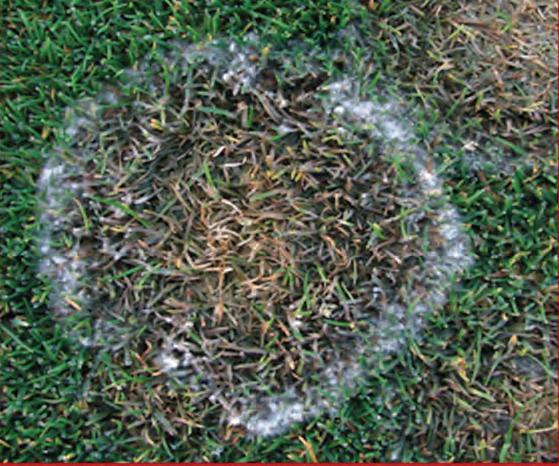
The source of infection, the conidia and hyphae can lie dormant in organic matter and thatch until dormancy is broken by environmental changes, allowing for germination and growth. This ability to remain dormant for long periods is significant for turfgrass management, ensuring low levels of organic matter will reduce the source of Microdochium inoculum. When environmental conditions are conducive, the conidia germinate and/or the hyphae commence growth and begin the infection process. Hyphae will grow over the sheath onto the leaves, and can be observed as pinkish/white mycelium, especially early morning. Infection occurs via stomatal penetration. Once inside the leaf, hyphae will extend, via intercellular spaces, before penetrating the cells, extracting nutrients, causing loss of turgor, discoloration, and collapse. This is when disease symptoms are clearly observable on the playing surfaces. The hyphae continue to grow, then exit, via the stomata, releasing numerous conidia, which are disseminated by natural means but also by golfers, and maintenance equipment.
Concisely, the pathogen wants to get into our turfgrasses, extract nutrients, exit and reproduce!
• Hyphae/conidia are the main source of inoculum.
• Environmental conditions allow infection to commence.
• Mycelium grows from the base of the plant.
• Infection by means of stomatal penetration.
• Infects the plant extracting nutrients.
• Exits plant producing conidia which are disseminated.
Integrated Pest Management (IPM) techniques are best employed, comprising of establishing disease threshold levels, intensive field monitoring, good record keeping, awareness of climatic conditions, and importantly, utilisation of non-pesticidal disease control strategies. Fungicide use is the last step in the IPM process.
A key component of non-pesticidal disease management is the use of the ‘Disease Pyramid’, this is used to identify and influence the factors which combine to determine the level of disease incidence and severity. There are four interacting factors:
• Host Plant.
• Pathogen.
• Environmental conditions.
• Time.
Host plant
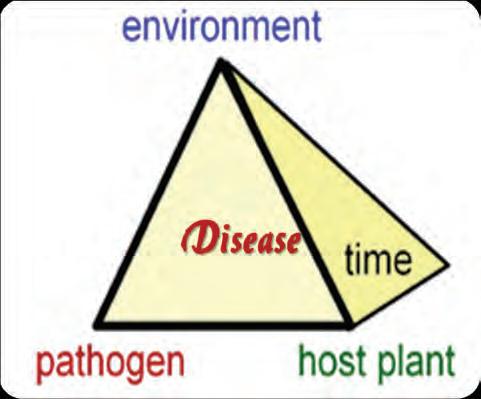
The sward composition in your site has a significant impact on the level of disease incidence Poa annua is more susceptible to Microdochium nivale than Agrostis spp or Fescue, it makes good sense to consider species conversion, or to increase percent composition of the less susceptible species at your site. There is increasing availability of new, more disease resistant cultivars and improved methods of interseeding now available, Turfgrass Consultancy will advise you better than I can of how best to proceed in this area.
The inoculum of Microdochium nivale, is in the soils, the thatch layer, general environment, and unfortunately there is little we can do about that. But conducive environmental factors are crucial for a disease outbreak, and we can do a lot in this area.
Environmental conditions
Influencing environmental factors not only means weather/climatic conditions, but also the growth environment and how nutritional and maintenance programs can be used to reduce disease pressure.
Plants, including turfgrasses, have evolved complex defense mechanisms to protect themselves from pathogens. They must first recognise they are under attack; this involves elicitors. They then produce short term responses aimed at containing the infection, they will produce antimicrobial compounds (like anti-bodies), which will directly inhibit the pathogen. Plants then use signaling compounds, such as Salicylic acid, which can lead to Systemic Acquired Resistance, i.e., resistance to the pathogen in uninfected parts of the plant and be primed to fight off any following infections. This is the Time factor of the Disease Pyramid We need to slow the infection process but speed up the plants defence response. There are no free lunches though, defences require generation of numerous compounds, and the plants need the reserves to produce them. This is where an Autumn/Winter program of cultural procedures and targeted nutrition can play a significant role.
Research has shown the significant impact Leaf wetness duration has on Microdochium infection. Microdochium is most likely to occur when leaf wetness is maintained for 24 h or more. All steps should be taken on turf surfaces to remove dew and maintain a dry surface during times conducive to Microdochium development, this will slow the infection process.
Dragging/switching the turfgrass surfaces are simple methods for removing dew, and their impacts on disease can be significant. The use of ‘dew dispersal’ surfactants can also be effective at reducing disease incidence, as results from the STRI have shown. While these products are effective, the longevity of their impact will vary with product, turfgrass growth and environmental conditions.
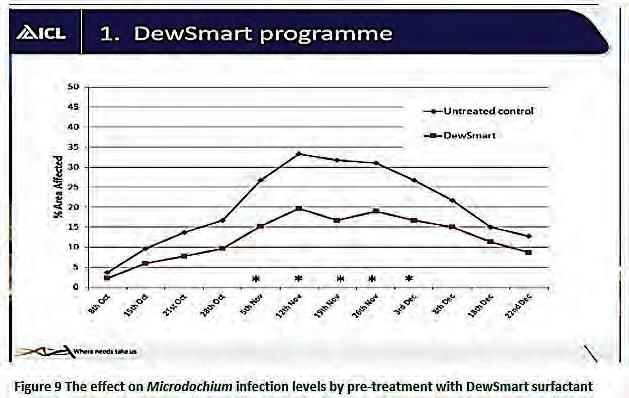
is crucial, (chainsaws are useful tools!). Prune anything that limits light, as the sun angles decline during Autumn. Apart from helping to maintain drier surfaces, light levels have an important impact not only on turfgrass quality but is vital for the acclimation of turfgrass to winter stresses. Inadequate light leads to weakened swards, poor root systems, and reduced reserves of energy, making them more susceptible to disease!
Raising mowing heights can help considerably, this increases leaf area and net photosynthesis, allowing turfgrass to generate and store carbohydrates necessary for defence compounds. Soil N levels can be high in late summer, a spike in growth can rapidly deplete carbohydrate reserves leaving levels dangerously low. If carbohydrate production outpaces carbohydrate use, then reserves will increase.
To help maintain acceptable playing standards, light-weight rolling can be incorporated into your maintenance program. This will have a combined effect of removing dew, maintaining playing quality and, as research from Oregon State University has shown, regular rolling will significantly reduce Microdochium infection.
Nutritional programs play an important role in combating Microdochium infection. Nutrition at this time of year should be geared to providing growth and recovery through the Autumn/Winter season and building carbohydrate reserves. Apart from supplying nutrition, many elements and compounds have a direct effect on suppressing Microdochium.
Ferrous sulphate has long been used to ‘harden’ turfgrass and improve colour, but does it suppress Microdochium? There are several studies showing that whether applied as Ferrous sulphate heptahydrate, or as a chelated liquid form, it will it help suppress this disease.
Combinations of Manganese and Zinc are increasingly used in Autumn/Winter programs, and this is not surprising. These elements serve as activators for several enzymes that lead to production of defence related compounds.
Sulphur has been shown to suppress Microdochium patch on bentgrass as far back as 1975. More recently in Oregon State University, Sulphur, applied monthly, significantly reduced Microdochium infection and reduced the number of fungicide applications required. Copper has been used to control disease as far back as the 19th century and has proven effective in combination with Sulphur.
One of the key roles Calcium plays is as a component of the ‘Ion Flux’ which is part of the first defence responses to infection. Calcium can be relatively immobile once absorbed into the plant, so ensuring there is a readily available supply is vital.
Silica has both a physical and biochemical effects on disease suppression. Deposition in the plant following foliar application will inhibit cell penetration and slow the infection, allowing time for defence induction. Biochemically, Silica can also enhance defence related activation.
In a similar manner to Silica, other compounds which could be included in the Autumn/Winter program can be classed as ‘Defense Activators’. These, when used prior to onset of infection can prime or enhance the turfgrass defences.
Chitin
Chitin is a primary component of the cell walls of fungi. During infection, fragments of the
fungal pathogen – Microdochium, can break off and act as elicitors, initiating defence inducement. Applying Chitin containing products, the plants can be stimulated to begin defence activation.
Salicylic acid is a key signaling compound leading to Systemic resistance, in a similar way to Chitin, pre-treatment with Salicylic acid can kick start defences, acting in a similar way as a vaccine for us humans.
Phosphorus, a major plant nutrient is taken up by plants as Phosphate (PO4) and is vital for numerous metabolic processes. Phosphite (PO3) is very similar chemically but has one less Oxygen molecule and does not provide any nutritional value. Published research, however, shows Phosphite not only directly inhibits Microdochium, but primes turfgrass defences, reducing infection by 60% compared to Controls.
An important point to note is that while the above factors, individually will have some effect on Microdochium, its only when you start combining them that you will see significant effects.
A program containing Phosphite, Calcium, Salicylic acid, Manganese, Zinc Sulphur, and Chelated Fe suppressed Microdochium incidence by 72% compared to Controls.
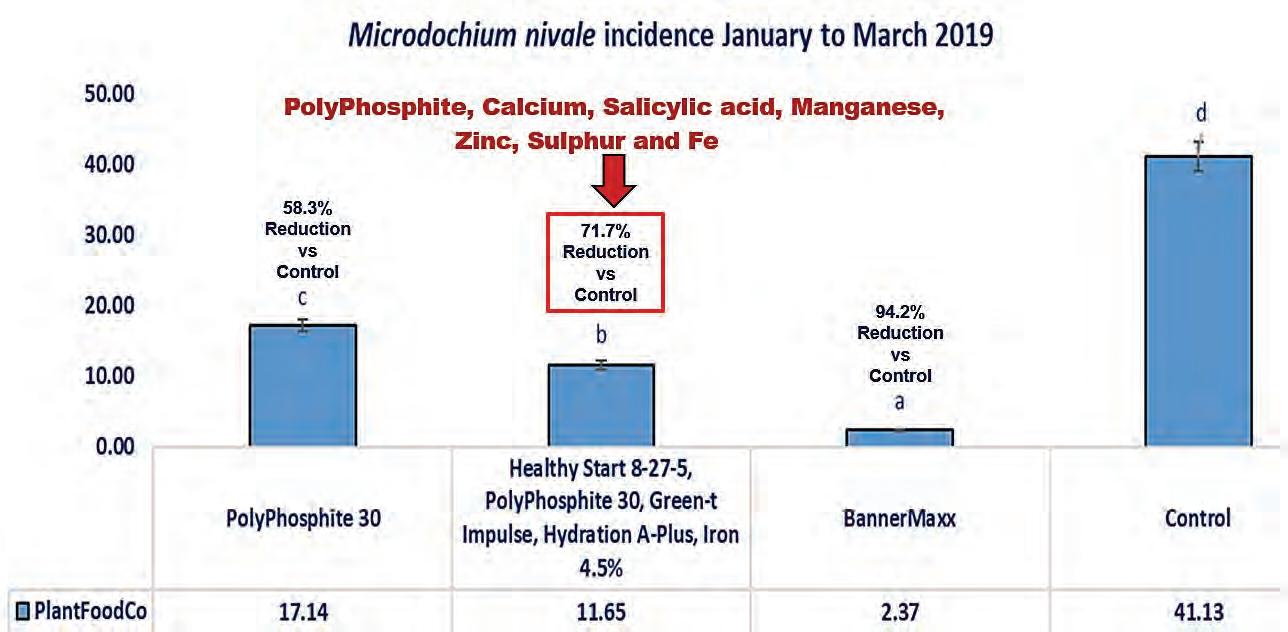
Research from Oregon State University shows significant Microdochium suppression by Sulphur, Phosphite (KPhite) and rolling, with full control by combination of all three.
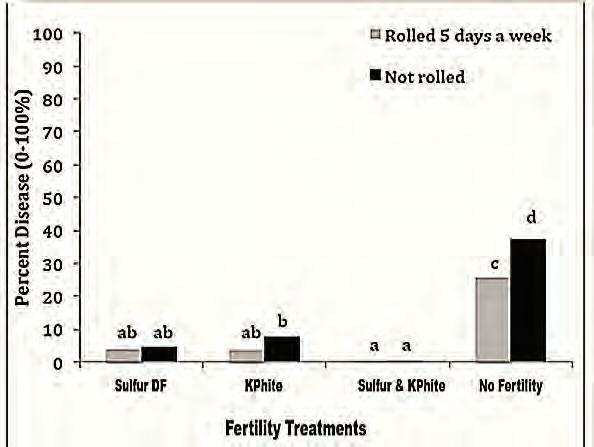
Research results from 2020/2021, containing a combination of Phosphite with a Copper based pigment and Phosphite with Manganese, Zinc, showed consistent suppression of Microdochium throughout the season, with a mean suppression rate of 76% compared to Controls.

Chemical plant protectants are an integral but final step of IPM. Most available fungicides these days are systemic and to be effective they need to be applied prior to any disease symptoms develop. Preventative applications of these fungicides can provide good control of Microdochium and while the efficacy and safety of these products is not disputed, their use can give rise to several contentious issues: adverse public opinion due to the perception of high frequency of use, associated costs of chemicals, possible inhibition of non-target beneficial microorganisms, development of fungicide resistant populations, and there are severe restrictions and the availability fungicides. This makes the options of non-pesticidal controls ever more attractive.
Ensuring good plant health and managing conditions conducive to Microdochium infection is the key for successful non-pesticidal control of Microdochium. Disease control is best implemented by means of IPM and using the Disease Pyramid to influence the factors conducive to infection.
Starting from the end of Summer ensure all environmental pressures are reduced as much as possible. Control of growth rates are required to conserve plant carbohydrate stores, achieved by increasing mowing heights, balanced nutrition, and PGR applications.
Key points:
Influence all factors which reduce the microclimate conducive to Microdochium development.
• Dew removal is vital as extended periods of leaf wetness is a key factor for infection.
• Increasing air movement through tree management will also help.
• Late season aeration operations and topdressing can create the ideal microclimate for infection, if possible, try to complete prior to Autumn. Bear in mind however, that thatch reduction will help reduce inoculum sources.
• Raise height of cut, turfgrass need to generate and store energy for defences.
• Incorporate rolling as much as feasible into the program.
• Nutritional programs to include compounds such as Phosphite, Manganese, Zinc, Sulphur, Salicylic acid, and Fe as part of balanced, sequentially applied, nutritional treatments.

John has 40 years greenkeeping experience and was Superintendent of Ireland’s oldest golf course –The Royal Curragh from 1993 to 2019. Academic qualifications include a 1st class Honours Degree in Turfgrass Science and a PhD in Plant Pathology at the University of the West of England, Bristol.
John has conducted independent research on turfgrass disease management for the past 15 years and has headed Independent Turfgrass Research since 2019. Research interests have covered extensively the subject Microdochium nivale, turfgrass responses to biotic and abiotic challenge and the effect of nutritional programs on disease suppression, turfgrass growth and quality.
John has presented the results of his research at numerous conferences in Ireland, Scotland, France, Germany, Norway, Canada, Sweden, Czech Republic and at GIS in the USA and BTME in Harrogate, UK.
Research can be accessed at https://orcid.org/0000-0002-4745-1541
Contact info:
EMAIL: drjjdempsey@gmail.com
X/Twitter: @J_J_Dempsey

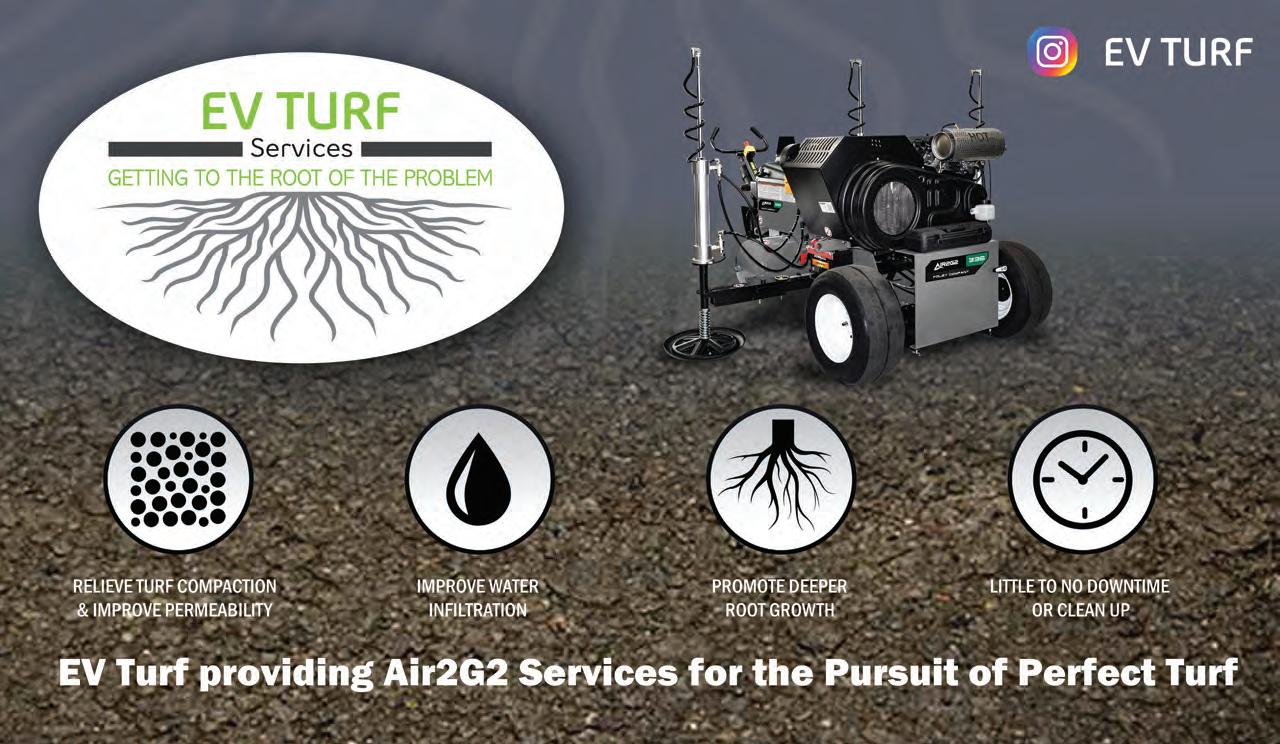
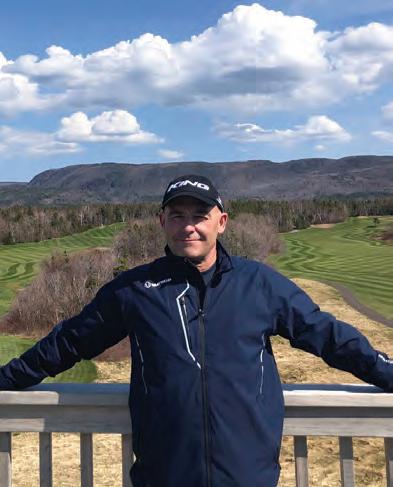
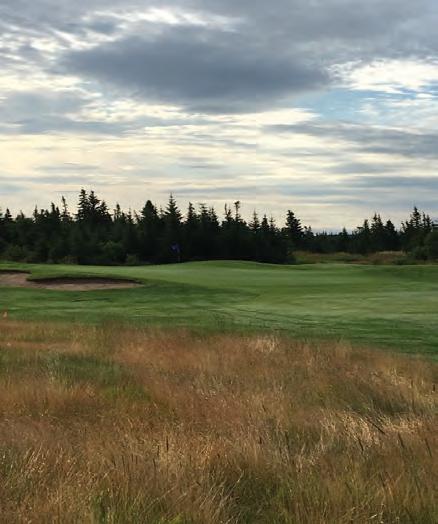


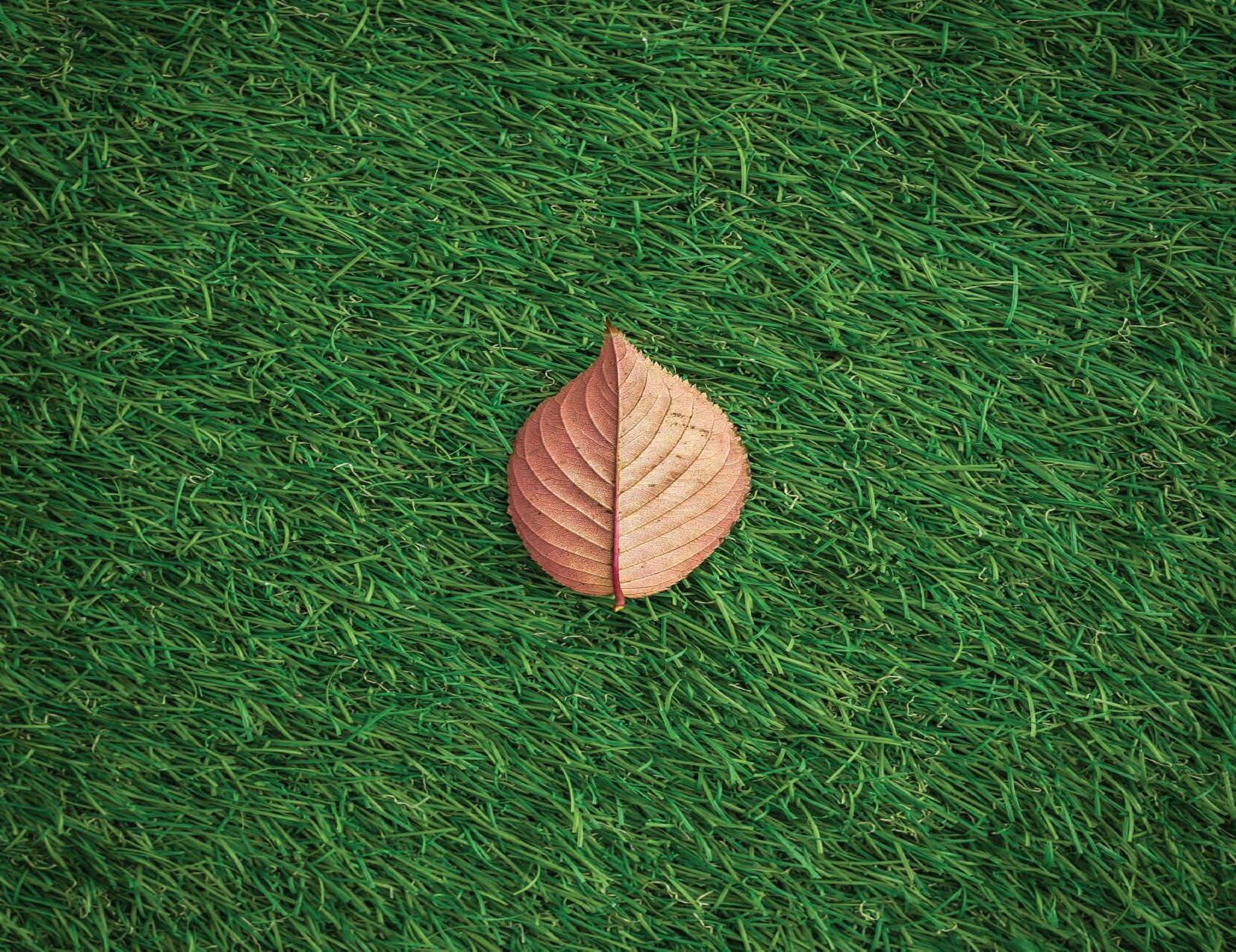
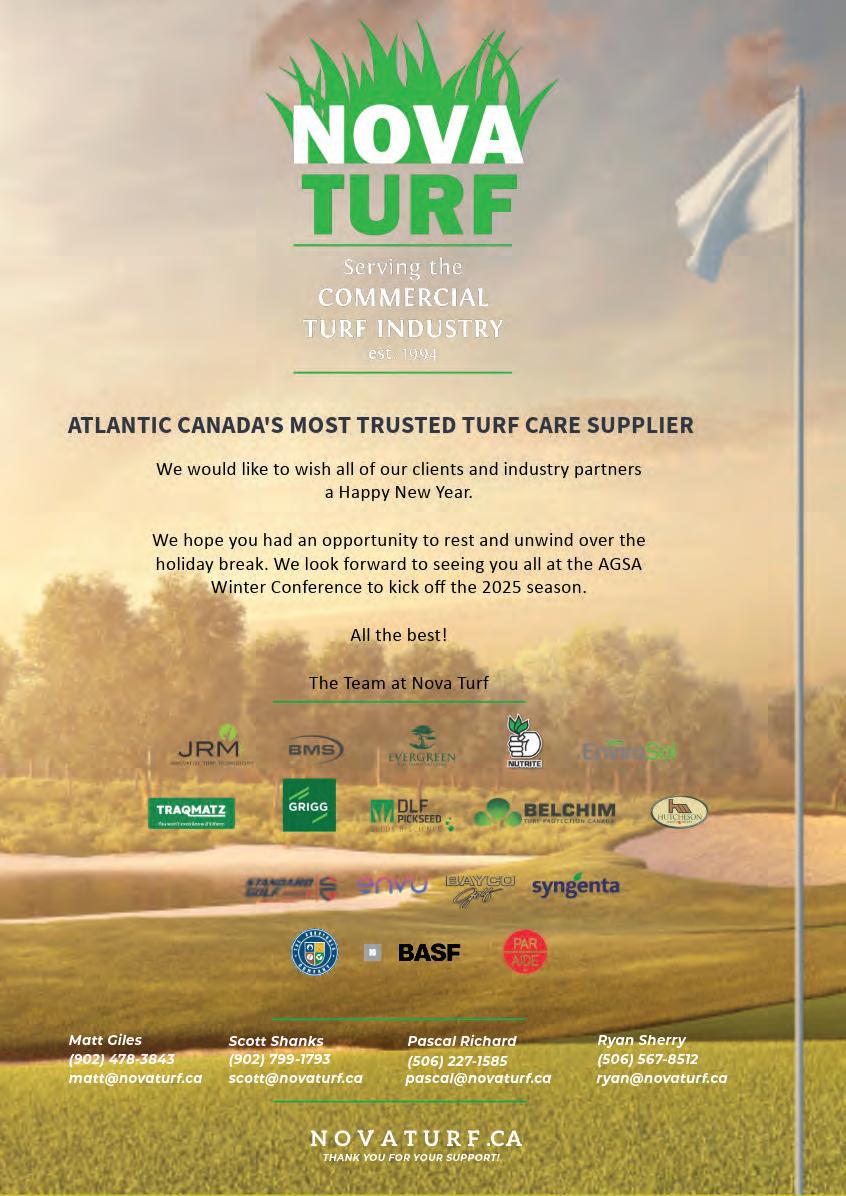


AQUATROLS EARLY ORDER HAS NEVER BEEN EASIER!
Start earning points the day you sign up & make purchases, and continue earning all year long. With Approach you not only get double points for your purchases during the EOP period, but also the opportunity to earn single points for your in-season purchases as well!
Key benefits of the 2025 Approach Early Order Program include:
KEY PROGRAM DATES
EARN DOUBLE POINTS DURING EOP!
EOP STARTS: October 1, 2024
EOP ENDS: April 30, 2025
Earn points on purchases all year
Earn points as soon as distributors report purchases

When it comes to managing a golf course, one of the biggest financial decisions you’ll face is equipment replacement.
Whether you’re outfitting a new facility or updating your current fleet, the right choices can have a lasting impact on both the quality of course maintenance and the bottom line. Every golf course has its own set of financial constraints, operational needs, and goals. Some courses are dealing with large budgets, while others are working with a more modest financial picture. Regardless, the process of selecting, financing, and maintaining equipment demands the input of several key players: the superintendent, the mechanic, the management team, and ownership.
Understanding how to make smart equipment replacement decisions isn’t just about purchasing what’s most current or cutting-edge; it’s about planning for the future while balancing fiscal responsibility. Here’s a guide to navigating the complexities of replacing golf course maintenance equipment with confidence.
One of the most common questions golf course operators face is whether to lease or buy equipment. Both options have distinct advantages and drawbacks, and the decision hinges largely on your course’s unique needs. Leasing offers more flexibility, allowing you to spread payments over several years without a large upfront investment. Leasing can also ensure that your fleet remains up to date with the latest technology. This is particularly important for high-use
equipment like mowers and golf carts, where performance and efficiency are critical for both course presentation and operational efficiency. Leasing also provides the opportunity to easily replace equipment every few years, preventing the high maintenance costs associated with aging machinery.
On the other hand, buying gives you full ownership, making sense for long-term investments like tractors, aerators, and other lower-use items that don’t require frequent updates. However, buying comes with the burden of a large initial capital expenditure and the potential for higher long-term maintenance costs if not carefully planned.
• How long will you keep the equipment?
Leasing may be the better option for equipment with shorter life cycles, while buying may be better for longterm tools.
• How important is the latest technology?
Leasing allows you to stay current with technological advancements, while owning equipment locks you into its current state.
• How is your cash flow?
Leasing requires less upfront capital but could be more expensive over time. Buying offers no interest or fees but demands a significant initial investment.
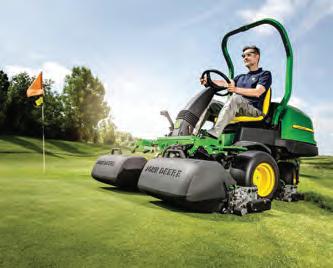
Once you’ve decided on leasing, you’ll face another decision: which type of lease best suits your needs?
The two most common options are Fair Market Value (FMV) leases and Dollar Buyout/Conditional Sales Contracts (CSC)
• FMV Leases are ideal for highturnover items like mowers and golf cars, which benefit from regular updates. At the end of the lease term, you can either return the equipment and lease new models, or buy the equipment for its residual value. This option ensures your fleet remains in top condition while keeping maintenance costs down.
• CSC Leases are best suited for equipment that has a longer useful life, such as tractors, sprayers, and aerification equipment. These leases are structured as lease-toown arrangements, allowing you to eventually take ownership of the equipment after the lease term ends. The longer useful life of this equipment justifies the investment, as it can continue to serve your course for many years.
One key strategy for maintaining a well-functioning fleet is Rotational Management. By following a planned rotation schedule, you can manage both high-use and low-use equipment effectively without overburdening your budget or maintenance team. For high-use equipment like greens mowers, fairway mowers, and rough mowers, a 3- to 5-year replacement cycle makes sense. These machines accumulate the most hours during the season and require the most regular
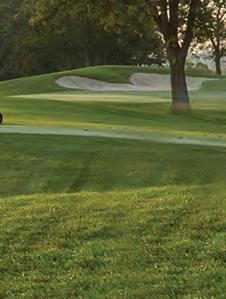
maintenance. Leasing allows for a smooth transition to newer models, ensuring high performance and reducing repair costs over time. For long-term equipment like tractors, aerators, and rollers, a rotation every 7 to 10 years can help keep these tools operational without unnecessary replacements. Establishing a long-term replacement strategy for these pieces reduces the risk of large unexpected expenditures by spreading the cost over time.
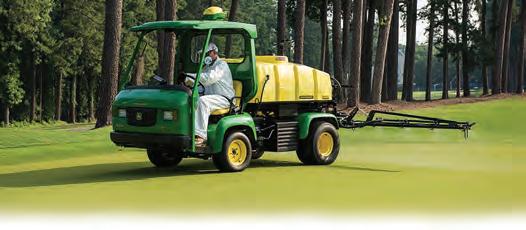
Purchasing - Pros:
• No interest or fees if you have the capital available.
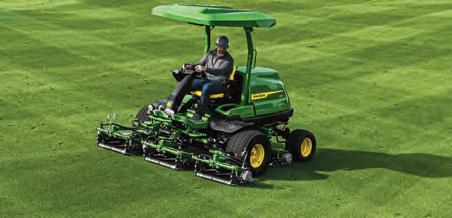
and equipment performance. You can even consider and finance the attractive extended warranty offers to match your 5-year lease with 5 year full coverage.
• Best for equipment expected to be used for 7-10 years or more.
• No ongoing lease obligations
Purchasing - Cons:
• Large upfront capital requirement.
• Higher long-term maintenance costs if equipment ages or isn’t replaced in time.
Here’s a breakdown of the financial implications of leasing and buying equipment:
Leasing - Pros:
• Easier to budget with fixed payments.
• More flexibility to acquire newer equipment.
• Avoid large upfront costs, making it more accessible for properties with limited cash flow.
• Lower maintenance costs on newer machines, often with warranties included.
Leasing - Cons:
• Higher interest rates compared to some financing options.
• Some accounting practices might favor owning over leasing due to depreciation considerations.
When it comes to purchasing equipment, several financing options are available to clubs looking to spread the cost over time. For instance, John Deere Financial offers flexible financing options with interest rates ranging from 4% to 7%. This can help golf courses purchase new or used equipment while managing cash flow more effectively. Other programs, such as the MultiUse Account from John Deere, provide more flexibility by offering 30- to 180-day no-payment options, making it easier for clubs to manage parts and service purchases alongside equipment financing.
By exploring all available financing options, golf courses can choose the best solution for their specific needs while maintaining healthy cash flow
Navigating the complex landscape of golf course equipment acquisition requires thoughtful consideration of your budget, operational needs, and long-term goals. Whether you decide to lease or buy, a well-crafted plan can help ensure that your equipment serves your course efficiently and costeffectively.
By working with trusted industry partners, developing a clear rotation strategy, and taking advantage of flexible financing options, you can make informed choices that enhance both the performance of your course and the satisfaction of your members and guests.


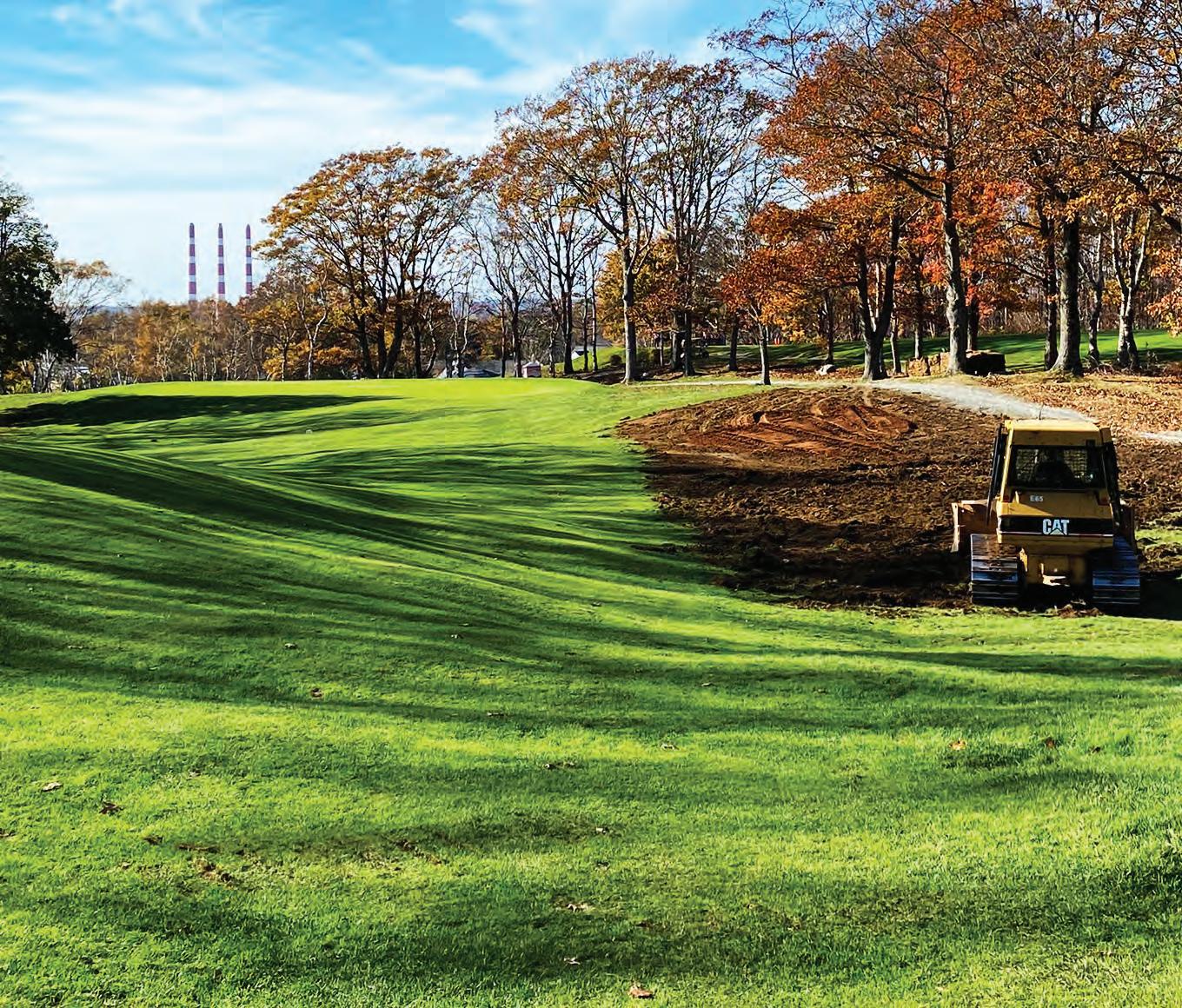
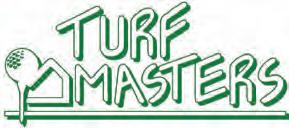
"Overthepast4yearswehavehadtheprivilegeofworkingwithTurfMastersonourmasterplan. Theyhavebeenoutstanding.Thequalityofworkhasbeentothehigheststandard.Notaskor problemistoobig.Theowner,AndyStreatch,isareliableandprofessionalmanwithaskillset thatwillensureexcellentresults.Ourgolfcoursehasbeentakentoanotherlevellargelythanks totheconstructionexpertiseofTurfMasters.”
- Sue Crawford, Superintendent,
